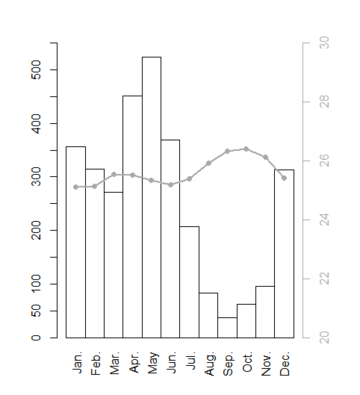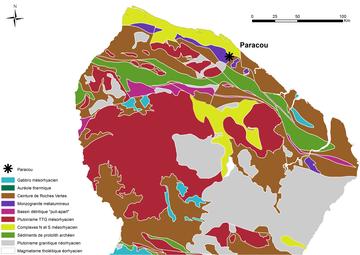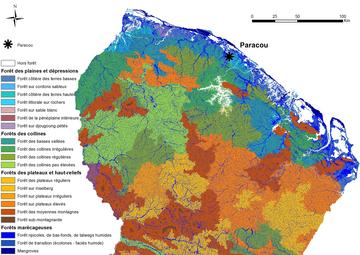Milieu
Climate
The climate is equatorial, strongly influenced by the movement of the Intertropical Convergence Zone which determines two main climatic periods: a well marked dry season occurring from mid-August to mid-November and a long rainy season, often interrupted by a short drier period between March and April. The mean annual rainfall in French Guiana decreases from the north-eastern region where it exceeds 4 m, to the north-western, western and southern regions where it is less than 2 m. Records made at Paracou give a mean annual rainfall of 3,041 mm with a minimum in September and a maximum in May. The mean annual temperature is 26 °C with an annual range of 1 to 1.5 °C. Winds are generally weak (never exceeding 20 m/s), averaging 2-3 m/s and mainly oriented ENE.
ombrothermic diagram
Geology
French Guiana is part of the geological unit called the “Guiana Shield”, which spreads from the Amazon River to the Orenoque River. It is characterized by Pre Cambrian granitic and metamorphic formations, highly eroded, associated mostly with gently undulating landscapes and a very dense hydrographic system. The terra firme hilly region corresponding to these formations covers 94% of French Guiana. To the north of the department, the hills progressively give way to lowlands, small coastal plains developed on quaternary alluvial sediments. The Paracou site is located in the northernmost part of the hilly area, on a formation called the “série Armina”, characterized by schists and sandstones and locally crossed by veins of pegmatite, aplite and quartz. The hydrographic system is globally oriented SW–NE. The relief of the site consists of small elliptic hills separated by narrow (<5 m wide) sandy waterbeds. The altitude varies from 5 to about 45 m above sea level.
Vegetation
Except for a few forest types limited to specific soil or topographic conditions (white sands, outcropped lateritic duricrusts, inselbergs, swamps or river banks), most of French Guiana is covered by lowland terra firme rain forests. The richness of tree species is relatively high in these ecosystems, with 150-200 species/ha reported for trees having a diameter at breast height (DBH) above 10cm. Alpha-diversity is slightly lower than in the forests of western Amazonia, but reaches the highest values on the Guiana Shield. Variations in floristic composition and species richness are result from the superpositioning of various gradients: at the local scale, ecological gradients such as soil drainage and composition, or light availability along gap successional phases; at the landscape and regional scales, topographic (micro- and meso-), climatic, and historical (biogeographical) gradients. A botanical few families are almost always present (the Lecythidaceae, Leguminosae, Sapotaceae and Chrysobalanaceae). Two families, Burseraceae and Caesalpiniaceae, play a much more contrasted role, leading to the distinction of two main facies in old-growth lowland terra firme forests. The Paracou forest belongs to the Caesalpiniaceae facies.



